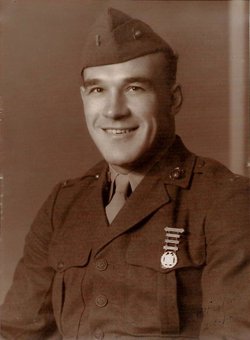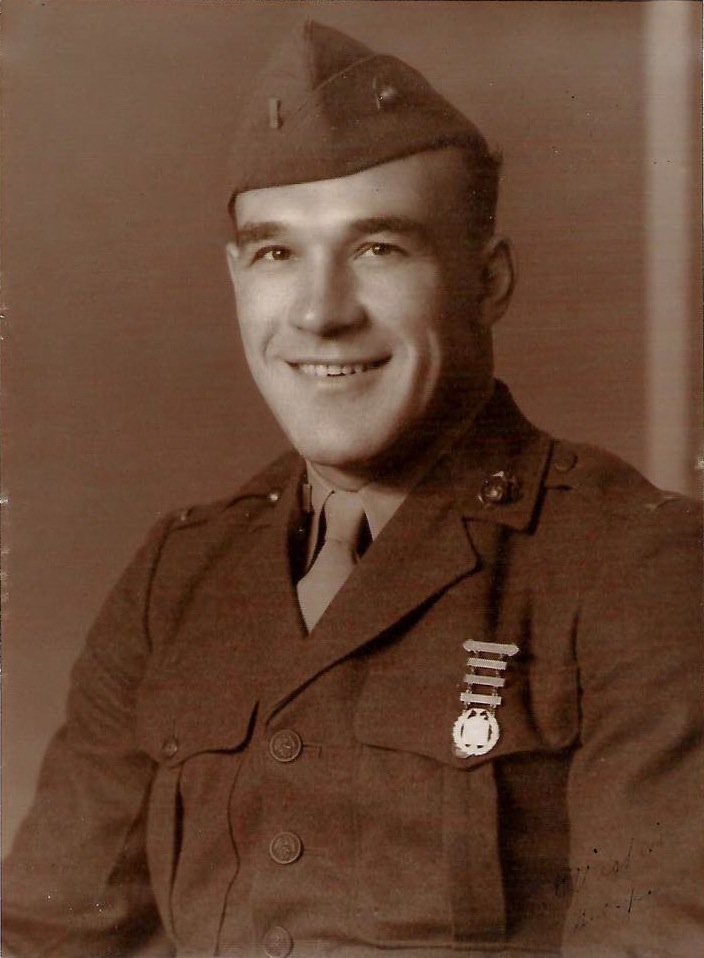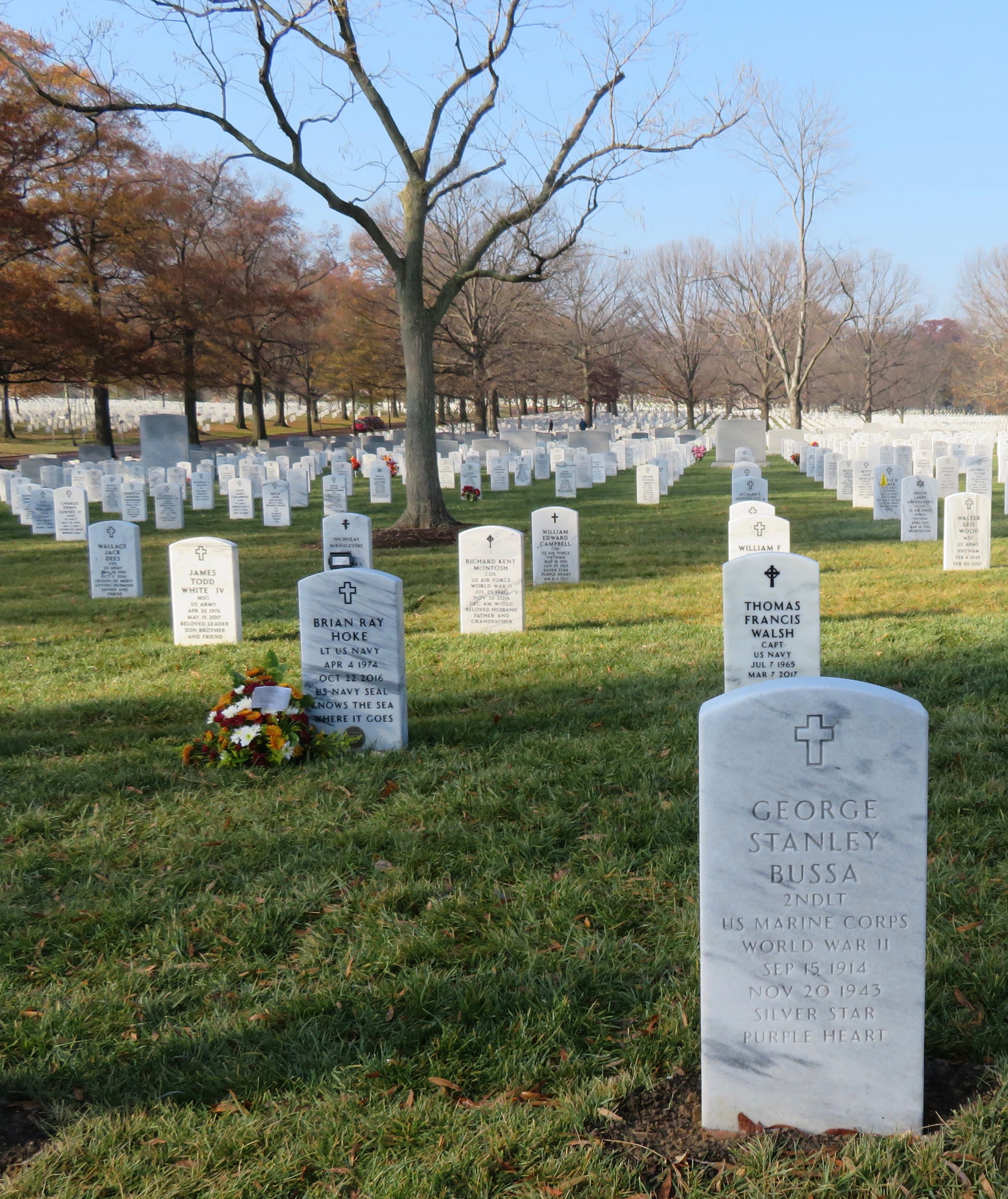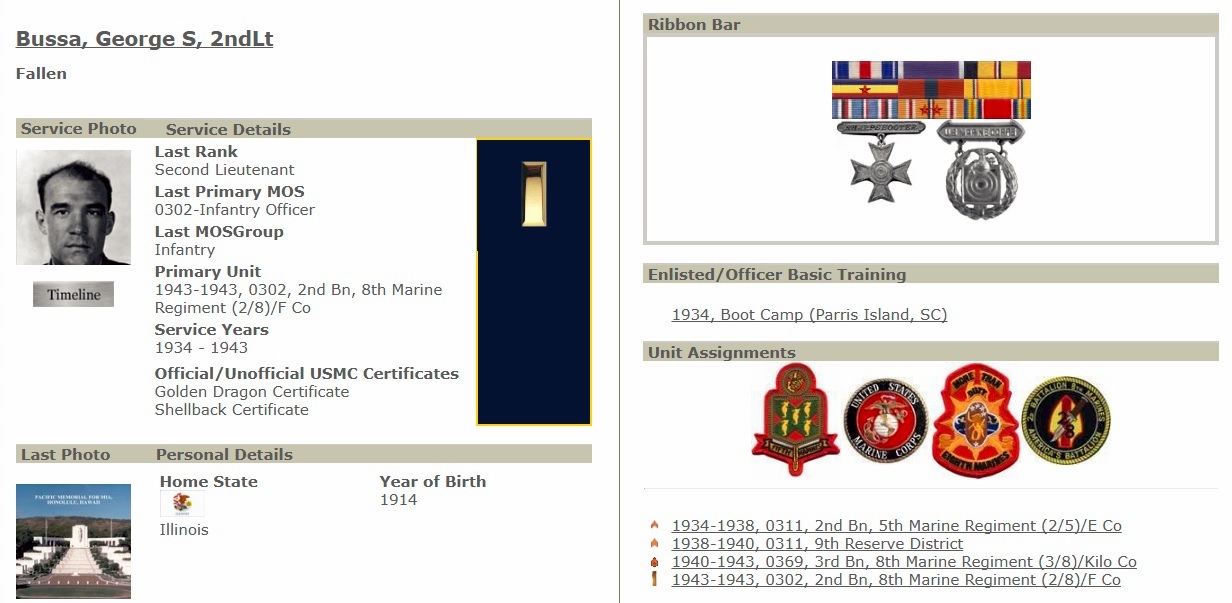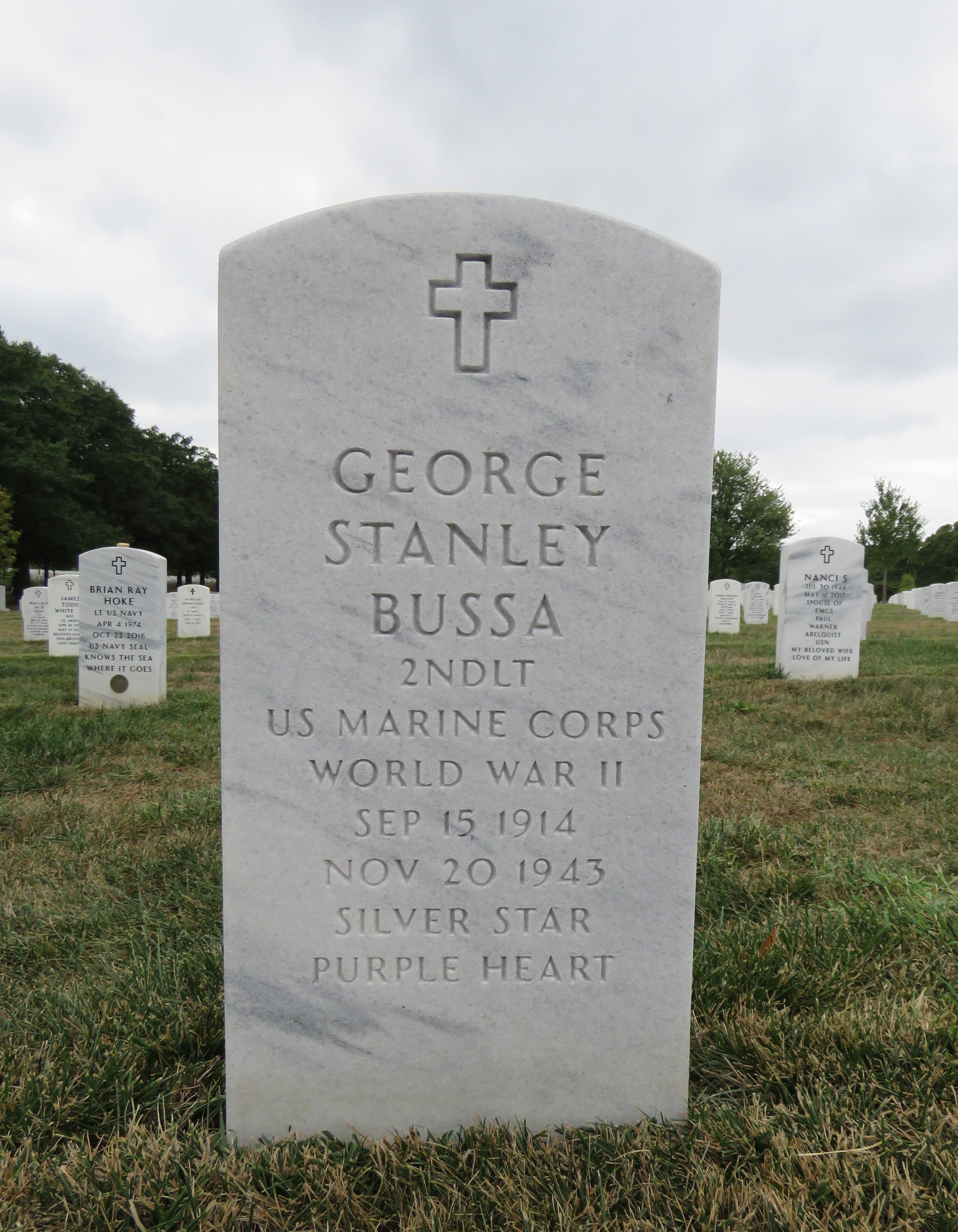Born in Chicago on September 15, 1914, George was the oldest of 5 children blessed to the union of Andrew Sr and Clara Stanislava (nee Pratt) Bussa. Soon after, their loving home would welcome Andrew Jr, Harry Leonard, William Robert and their baby sister, Evelyn.
In August of 1934, the 19-year-old Bussa boy enlisted in the United States Marine Corps, trained in Parris Island, South Carolina and the following month was stationed at Marine Barracks Quantico. George was primarily with Company F, 2nd Battalion, 5th Marine Regiment of the 1st Marine Brigade at Quantico, with additional training stints on Cristóbal & San Clemente Island (both, via the USS Wyoming), at Camp L. M. Little in Culebra, Puerto Rico and at Camp R. P. Williams in Brentsville, Virginia.
In August of 1938, he was promoted to Sergeant before being attached to the General Service Unit, 9th Reserve District; later joining Kappa Company, 3rd Battalion, 8th Marine Regiment (K-3/8) of the 2nd Marine Division.
After being transferred to Marine Corps Base San Diego, George met Miss Helen Lenore Walsh and they were wed at Christmas time, 1941. To this union was born George's only child, Jerilyn Ann, on September 9, 1942.
Platoon Sergeant Bussa shipped out into the Pacific Theater along with the rest of Kilo Company and, in April of 1942, were stationed at Tutuila, American Samoa.
The following October, PLSGT Bussa was aboard the USS Hunter Liggett, bound for the Solomon Islands. "After his platoon leader was evacuated for illness, Platoon Sergeant Bussa took command and personally led his platoon into action in the ravine west of Point Cruz and at all times fought bravely. Against heavy opposition the men under his leadership destroyed three enemy machine guns and other weapons. He accompanied the Company Commander and the Demolitions Officer into the enemy lines to locate targets. With the fire of his platoon he covered the demolition party while enemy positions were destroyed." For his valiant actions on 15 January 1943 in the Battle of Guadalcanal, PLSGT George Stanley Bussa was awarded the Silver Star.
----------------------
SILVER STAR
Rank: Platoon Sergeant (Colour Sergeant)
Unit: Company F, 2nd Battalion, 8th Marine Regiment, 2nd Marine Division, U.S. Marine Corps
Awarded on: February 22nd, 1943
Citation: "For gallantry in action on 15 January 1943, on Guadalcanal. After his platoon leader was evacuated for illness, Platoon Sergeant Bussa took command and personally led his platoon into action in the ravine west of Point Cruz and at all times fought bravely. Against heavy opposition the men under his leadership destroyed three enemy machine guns and other weapons. He accompanied the Company Commander and the Demolitions Officer into the enemy lines to locate targets. With the fire of his platoon he covered the demolition party while enemy positions were destroyed."
Details: General Orders No. 47, Headquarters United States Army Forces in the South Pacific Area (February 22, 1943).
----------------------
Bussa and many of his brothers-in-arms were then sent to New Zealand for some R&R - and George received another promotion. There had been numerous letters home, photos of his baby girl, well-wishes and word of how his brothers faired abroad. Eventually, the time came to prepare for the next battle.
Second Lieutenant Bussa was with his brothers in Foxtrot Company, 2nd Battalion of the 8th Marines (F-2/8) when they landed on Betio as part of Operation: GALVANIC. The mission of the 2nd Marine Division was to secure the island in order to control the Japanese airstrip in the Tarawa Atoll; thereby preventing the Japanese Imperial forces from getting closer to the United States, and enabling US forces to get closer to mainland Japan. It would become one of the bloodiest battles in the Corps history.
It was November 20th (D-Day for the "Battle of Tarawa"), when young George - just 29 years old - perished. He was reportedly buried in a cemetery on Betio Island - a temporary location until the Fallen could be recovered and returned to their families.
Having a loved one away from home during the holidays is always trying; however, having a son or husband off fighting in the war left the whole family on edge. The fact that this battle took place just before Thanksgiving meant that most of the families, who had unknowingly earned their Gold Star, would receive their heart-wrenching telegrams on Christmas Eve – some Christmas Day or even New Years Day.
Christmas was particularly somber and painful as word reached home - to the young Mrs Bussa and her infant daughter in Los Angeles, and to Mr & Mrs Bussa in Chicago, with their other three sons also serving, and young Evelyn still in school.
Despite the heavy casualties suffered by U.S. forces, military success in the battle of Tarawa was a huge victory for the U.S. military because the Gilbert Islands provided the U.S. Navy Pacific Fleet a platform from which to launch assaults on the Marshall and Caroline Islands to advance their Central Pacific Campaign against Japan.
In the immediate aftermath of the fighting on Tarawa, U.S. service members who died in the battle were buried in a number of battlefield cemeteries on the island. In 1946 and 1947, the 604th Quartermaster Graves Registration Company conducted remains recovery operations on Betio Island, but 2LT Bussa's remains were not recovered. On February 9, 1949, a military review board declared George "non-recoverable".
For more than 66 years, George Stanley Bussa was lost in the foreign sands where he took his last stand.
In June 2015, History Flight notified the Defense POW/MIA Accounting Agency that they had discovered a burial site on Betio Island and recovered the remains of what they believed were 35 U.S. Marines who fought during the battle in November 1943. The remains were found in a grave corresponding to where Bussa was believed to have been buried, and were turned over to DPAA in June 2016.
In October of 2015, Jennifer Morrison, an independent volunteer forensic genealogist, located PlSgt Bussa's family and provided the contact information to the Marine Corps POW/MIA Section. This (re)established lines of communication with George's family regarding the ongoing recovery and repatriation efforts, and offered Robert Zalesky the opportunity to provide the Family Reference DNA Sample so necessary for his Uncle George's identification.
In May of 2017, Mrs Jeri Heise, George's daughter, received "The Call" from the Marine Corps POW/MIA Section. To identify Bussa's remains, scientists from DPAA and the Armed Forces Medical Examiner System used Mr Zalesky's mitochondrial DNA (mtDNA) analysis; dental analysis and anthropological comparison, which matched his records; as well as circumstantial and material evidence.
George Stanley Bussa was finally returned to his family and, on October 10, 2017, laid to rest at Arlington National Cemetery with full military honors.
Marine Corps Second Lieutenant George Stanley Bussa is memorialized among the National Memorial Cemetery of the Pacific's Honolulu Memorial. His name is permanently inscribed within Court 2 of the "Courts of the Missing" (56116891). A rosette has been placed next to his name to indicate that George is no longer missing.
SOURCE
Marine Corps POW/MIA Section
DPAA: News Release (October 3, 2017)
DPAA Recent News & Stories (April 21, 2017)
Silver Star Citation (Guadalcanal)
American Battle Monuments Commission
Jennifer Morrison, independent volunteer forensic genealogist
-----------------------------------------------------------------------
Note from the memorial maintainer:
I am grateful to Chuck Williams & Hattie Johnson (USMC POW/MIA Section), the Armed Forces DNA Identification Lab, History Flight and the DPAA for their efforts in bringing my Marine home. "It takes a village!"
Born in Chicago on September 15, 1914, George was the oldest of 5 children blessed to the union of Andrew Sr and Clara Stanislava (nee Pratt) Bussa. Soon after, their loving home would welcome Andrew Jr, Harry Leonard, William Robert and their baby sister, Evelyn.
In August of 1934, the 19-year-old Bussa boy enlisted in the United States Marine Corps, trained in Parris Island, South Carolina and the following month was stationed at Marine Barracks Quantico. George was primarily with Company F, 2nd Battalion, 5th Marine Regiment of the 1st Marine Brigade at Quantico, with additional training stints on Cristóbal & San Clemente Island (both, via the USS Wyoming), at Camp L. M. Little in Culebra, Puerto Rico and at Camp R. P. Williams in Brentsville, Virginia.
In August of 1938, he was promoted to Sergeant before being attached to the General Service Unit, 9th Reserve District; later joining Kappa Company, 3rd Battalion, 8th Marine Regiment (K-3/8) of the 2nd Marine Division.
After being transferred to Marine Corps Base San Diego, George met Miss Helen Lenore Walsh and they were wed at Christmas time, 1941. To this union was born George's only child, Jerilyn Ann, on September 9, 1942.
Platoon Sergeant Bussa shipped out into the Pacific Theater along with the rest of Kilo Company and, in April of 1942, were stationed at Tutuila, American Samoa.
The following October, PLSGT Bussa was aboard the USS Hunter Liggett, bound for the Solomon Islands. "After his platoon leader was evacuated for illness, Platoon Sergeant Bussa took command and personally led his platoon into action in the ravine west of Point Cruz and at all times fought bravely. Against heavy opposition the men under his leadership destroyed three enemy machine guns and other weapons. He accompanied the Company Commander and the Demolitions Officer into the enemy lines to locate targets. With the fire of his platoon he covered the demolition party while enemy positions were destroyed." For his valiant actions on 15 January 1943 in the Battle of Guadalcanal, PLSGT George Stanley Bussa was awarded the Silver Star.
----------------------
SILVER STAR
Rank: Platoon Sergeant (Colour Sergeant)
Unit: Company F, 2nd Battalion, 8th Marine Regiment, 2nd Marine Division, U.S. Marine Corps
Awarded on: February 22nd, 1943
Citation: "For gallantry in action on 15 January 1943, on Guadalcanal. After his platoon leader was evacuated for illness, Platoon Sergeant Bussa took command and personally led his platoon into action in the ravine west of Point Cruz and at all times fought bravely. Against heavy opposition the men under his leadership destroyed three enemy machine guns and other weapons. He accompanied the Company Commander and the Demolitions Officer into the enemy lines to locate targets. With the fire of his platoon he covered the demolition party while enemy positions were destroyed."
Details: General Orders No. 47, Headquarters United States Army Forces in the South Pacific Area (February 22, 1943).
----------------------
Bussa and many of his brothers-in-arms were then sent to New Zealand for some R&R - and George received another promotion. There had been numerous letters home, photos of his baby girl, well-wishes and word of how his brothers faired abroad. Eventually, the time came to prepare for the next battle.
Second Lieutenant Bussa was with his brothers in Foxtrot Company, 2nd Battalion of the 8th Marines (F-2/8) when they landed on Betio as part of Operation: GALVANIC. The mission of the 2nd Marine Division was to secure the island in order to control the Japanese airstrip in the Tarawa Atoll; thereby preventing the Japanese Imperial forces from getting closer to the United States, and enabling US forces to get closer to mainland Japan. It would become one of the bloodiest battles in the Corps history.
It was November 20th (D-Day for the "Battle of Tarawa"), when young George - just 29 years old - perished. He was reportedly buried in a cemetery on Betio Island - a temporary location until the Fallen could be recovered and returned to their families.
Having a loved one away from home during the holidays is always trying; however, having a son or husband off fighting in the war left the whole family on edge. The fact that this battle took place just before Thanksgiving meant that most of the families, who had unknowingly earned their Gold Star, would receive their heart-wrenching telegrams on Christmas Eve – some Christmas Day or even New Years Day.
Christmas was particularly somber and painful as word reached home - to the young Mrs Bussa and her infant daughter in Los Angeles, and to Mr & Mrs Bussa in Chicago, with their other three sons also serving, and young Evelyn still in school.
Despite the heavy casualties suffered by U.S. forces, military success in the battle of Tarawa was a huge victory for the U.S. military because the Gilbert Islands provided the U.S. Navy Pacific Fleet a platform from which to launch assaults on the Marshall and Caroline Islands to advance their Central Pacific Campaign against Japan.
In the immediate aftermath of the fighting on Tarawa, U.S. service members who died in the battle were buried in a number of battlefield cemeteries on the island. In 1946 and 1947, the 604th Quartermaster Graves Registration Company conducted remains recovery operations on Betio Island, but 2LT Bussa's remains were not recovered. On February 9, 1949, a military review board declared George "non-recoverable".
For more than 66 years, George Stanley Bussa was lost in the foreign sands where he took his last stand.
In June 2015, History Flight notified the Defense POW/MIA Accounting Agency that they had discovered a burial site on Betio Island and recovered the remains of what they believed were 35 U.S. Marines who fought during the battle in November 1943. The remains were found in a grave corresponding to where Bussa was believed to have been buried, and were turned over to DPAA in June 2016.
In October of 2015, Jennifer Morrison, an independent volunteer forensic genealogist, located PlSgt Bussa's family and provided the contact information to the Marine Corps POW/MIA Section. This (re)established lines of communication with George's family regarding the ongoing recovery and repatriation efforts, and offered Robert Zalesky the opportunity to provide the Family Reference DNA Sample so necessary for his Uncle George's identification.
In May of 2017, Mrs Jeri Heise, George's daughter, received "The Call" from the Marine Corps POW/MIA Section. To identify Bussa's remains, scientists from DPAA and the Armed Forces Medical Examiner System used Mr Zalesky's mitochondrial DNA (mtDNA) analysis; dental analysis and anthropological comparison, which matched his records; as well as circumstantial and material evidence.
George Stanley Bussa was finally returned to his family and, on October 10, 2017, laid to rest at Arlington National Cemetery with full military honors.
Marine Corps Second Lieutenant George Stanley Bussa is memorialized among the National Memorial Cemetery of the Pacific's Honolulu Memorial. His name is permanently inscribed within Court 2 of the "Courts of the Missing" (56116891). A rosette has been placed next to his name to indicate that George is no longer missing.
SOURCE
Marine Corps POW/MIA Section
DPAA: News Release (October 3, 2017)
DPAA Recent News & Stories (April 21, 2017)
Silver Star Citation (Guadalcanal)
American Battle Monuments Commission
Jennifer Morrison, independent volunteer forensic genealogist
-----------------------------------------------------------------------
Note from the memorial maintainer:
I am grateful to Chuck Williams & Hattie Johnson (USMC POW/MIA Section), the Armed Forces DNA Identification Lab, History Flight and the DPAA for their efforts in bringing my Marine home. "It takes a village!"
Inscription
GEORGE / STANLEY / BUSSA
2NDLT / US MARINE CORPS / WORLD WAR II
SEP 15 1914 ... NOV 20 1943
SILVER STAR / PURPLE HEART
Family Members
Sponsored by Ancestry
Advertisement
Explore more
Sponsored by Ancestry
Advertisement
